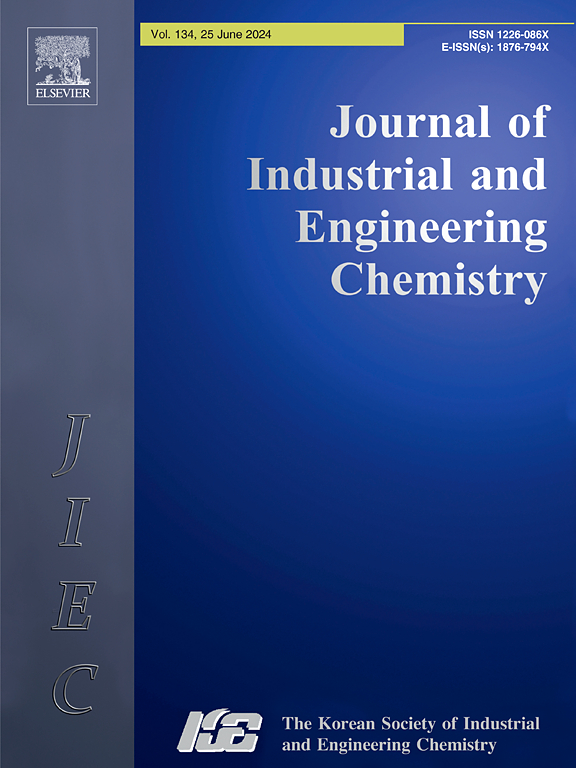Thermal reactivity and gas–solid product evolution during coal catalytic combustion: An experimental study
IF 5.9
3区 工程技术
Q1 CHEMISTRY, MULTIDISCIPLINARY
Journal of Industrial and Engineering Chemistry
Pub Date : 2025-01-25
DOI:10.1016/j.jiec.2024.07.008
引用次数: 0
Abstract
To achieve efficient and clean coal combustion, catalytic combustion technology has received widespread attention. This paper systematically studied the influence of calcium-based compounds on the thermal reactivity and gas–solid two-phase product evolution behavior of different coal using TG-MS and FTIR analysis, combining kinetics and thermodynamics methods, the catalytic coal mechanism was discussed. Results demonstrated that both catalysts improved the combustion reactivity, the burnout temperatures of lignite, bituminous coal and anthracite were reduced by 30.75 °C, 53 °C and 25.5 °C respectively with CaO, as well as decreased by 24.75 °C, 55.5 °C and 29 °C respectively with CaCl2. Meanwhile, it was worth noting that the activation energy of three coals was also reduced. CaCl2 was more likely to bind with the C = O functional group on the surface of coal, forming CO-Ca2+ complexes, resulting in a decrease in the content of C = O and C-O. While CaO tended to absorb volatile matter, causing local overheating and promoting the breakage of side chains and bridge bonds. Besides, the calcium-based compounds advanced the gas evolution peak of combustion and the emissions of CO2, NO2 and SO2 were effectively controlled. These results aimed at providing a new reference direction for further industrial development of clean coal combustion technology.

煤催化燃烧过程中的热反应和气固产物演化:实验研究
为了实现煤的高效清洁燃烧,催化燃烧技术受到了广泛的关注。本文采用TG-MS和FTIR分析系统研究了钙基化合物对不同煤的热反应性和气固两相产物演化行为的影响,结合动力学和热力学方法,探讨了煤的催化机理。结果表明,两种催化剂均提高了燃烧反应性,添加CaO可使褐煤、烟煤和无烟煤的燃尽温度分别降低30.75℃、53℃和25.5℃,添加CaCl2可使褐煤、烟煤和无烟煤的燃尽温度分别降低24.75℃、55.5℃和29℃。同时,值得注意的是,三种煤的活化能也有所降低。CaCl2更容易与煤表面的C = O官能团结合,形成CO-Ca2+配合物,导致煤中C = O和C-O的含量降低。而CaO容易吸收挥发性物质,引起局部过热,促进侧链和桥键断裂。此外,钙基化合物提前了燃烧的析气峰,有效地控制了CO2、NO2和SO2的排放。这些结果旨在为清洁煤燃烧技术的进一步产业化发展提供新的参考方向。
本文章由计算机程序翻译,如有差异,请以英文原文为准。
求助全文
约1分钟内获得全文
求助全文
来源期刊
CiteScore
10.40
自引率
6.60%
发文量
639
审稿时长
29 days
期刊介绍:
Journal of Industrial and Engineering Chemistry is published monthly in English by the Korean Society of Industrial and Engineering Chemistry. JIEC brings together multidisciplinary interests in one journal and is to disseminate information on all aspects of research and development in industrial and engineering chemistry. Contributions in the form of research articles, short communications, notes and reviews are considered for publication. The editors welcome original contributions that have not been and are not to be published elsewhere. Instruction to authors and a manuscript submissions form are printed at the end of each issue. Bulk reprints of individual articles can be ordered. This publication is partially supported by Korea Research Foundation and the Korean Federation of Science and Technology Societies.

 求助内容:
求助内容: 应助结果提醒方式:
应助结果提醒方式:


